Peter Coyote: Not just a pretty face and a golden voice, but once upon a time …a street charmer.
The Coyote Cycle: Answers from Peter Coyote
by J.Macon King
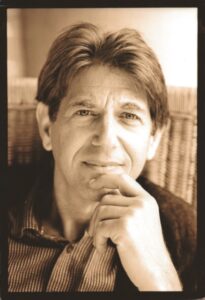
[Former] Mill Valley resident Peter Coyote is known for many accomplishments: actor, narrator, activist. He has also held a long time passion for the literary. Well before fame and fortune, he arrived in San Francisco from New Jersey to pursue a master’s in creative writing at SFS. Soon he was drawn into the outrageous guerilla theatre company, The San Francisco Mime Troupe. When he cosmically converged with the Svengali-esque (but probably nuts) Emmett Grogan, Grogan convinced Coyote to be a “life actor” rather than a stage actor. Why theater when social theater could be a round-the-clock cabaret? Coyote metamorphosed into a co-founder of the seminal, benevolent anarchists, the Diggers.
“…in 1966-8, such was the Diggers’ presence and notoriety that seemingly every reporter filing a story on the Haight included the Diggers in their account. “A band of hippie do-gooders,” said Time magazine. “A true peace corps,” wrote local daily newspaper columnist (and future Rolling Stone editor) Ralph J. Gleason. The Beatles’ press officer Derek Taylor would later write, “[The Diggers] were in my opinion the core of the whole underground counterculture because they were our conscience.” Jay Babcock, from his blog “Diggers Docs.”
The Digger philosophy was not only “free everything,” but the underground organization provided exactly that, feeding, housing, providing medical, protecting local poor and the innumerable naïve runaways who had flocked to psychedelic epicenter San Francisco in the late 60s. Using street theater and printing thought provoking slogans and flyers to break mindsets and boundaries; the Diggers became a unifying force in the nebulous and factious “movement.”
Other than Vietnam War opposition, musicians such as Dylan, Dead, the Airplane, ingestible therapy from men like Leary, Owsley, and Kesey – Coyote, the Diggers, and similar “edge dwelling” activists in the wake of Beat energy, did the most to rock the foundations of society. Coyote pursued ultimate freedom in the exhilarations and the despairs of a drug centric culture. Coyote became the ultimate Haight Street hippie before “hippie” was even a term. His was an endangered species, and Coyote is one of the fortunate few who survived. But more rarely, and importantly, he reticently found personal success while integrating into political appointment and the fame of Hollywood.
Understanding Peter Coyote could be the key to understanding the ‘60s, and hence ourselves – the heirs to that complex cultural earthquake. To understand Coyote, one should read his writing. In 1998, some thirty years on, through his earned wisdom, with some cynicism, regrets, and self-recriminations, Coyote published his experiences in his vivid tell-all memoir Sleeping Where I Fall. The book was released as a revised edition in 2009.
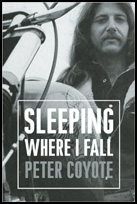 Coyote’s book is “high” on our Ultimate San Francisco Book list. If you care to know more than the rose-colored version of “Happy Hippie Days of Peace & Love”- read Coyote’s unvarnished inside story: the ill-fated Altamont concert from a Hell’s Angel eyes, the real “Invisible Circus,” the origin of “Easy Rider,” the commune life, a Christmas party in England with John Lennon and fisticuffs.
Coyote’s book is “high” on our Ultimate San Francisco Book list. If you care to know more than the rose-colored version of “Happy Hippie Days of Peace & Love”- read Coyote’s unvarnished inside story: the ill-fated Altamont concert from a Hell’s Angel eyes, the real “Invisible Circus,” the origin of “Easy Rider,” the commune life, a Christmas party in England with John Lennon and fisticuffs.
Take this passage about a grand entrance of Sweet William (Digger, a VP of Hells Angels SF Chapter, poet), and “porn” poetry trial famed Lenore Kandel ( “The Love Book”, Kerouac character, influencer) “…radiating charisma and self-assurance of natural leaders. … You could imagine them … They would know people who were never bored or plagued with self-doubts. You felt yourself sinking a bit in your own estimation by comparison.”
Or… “He was indisputably somebody. I felt that way about many of my friends then; though their fame was strictly local, they had an authority that rested on character and ability rather than on wealth or social status.” And, “It was as if the participants at a costume ball suddenly found the event too silly and simultaneously dropped their masks.”
The cautionary tales in his well-crafted book may surprise readers with its relevance today. Here Coyote he describes his and the Digger’s uneasy friendship with the notorious bad boys Hell’s Angels. “Though an “outlaw,” Pete (Knell, then President of San Francisco Chapter) was strict about obligations that the Diggers dismissed casually. … (Digger) Scruples about behavior (such as credit card fraud of politicians and corporations) were anesthetized by our image of ourselves as guerrilla warriors living off the enemy. … What strikes me in hindsight about my ethical transgressions … is not the revelation of a flaw in my character but the ease with which anyone can sweep away ethical concerns in pursuit of a noble goal. The facility which I performed these sleights of mind informs my caution today…so it no longer surprises me when prevalently high-sounding goals become transformed into justifications for malfeasance.”
Peter Coyote’s writing masterfully speaks volumes in a few pages of Introduction of the reprint to his mentor Emmett Grogan’s ‘60s memoir Ringovivio. (orig. pub. 1972, reprinted 1990)
We last wrote of Peter Coyote in regard to his appearance as famed literary editor Max Perkins in the HBO movie, “Hemingway and Gellhorn.” Peter and I clicked as fellow motorcyclist enthusiasts with the same classic BWM R90s, and many commonalities: “free frame of reference” in San Francisco, the Magic Theatre, music and writing. Our conversations resulted in our leafing through literary landscapes.
INTERVIEW:
King: I saw the Mime Troop numerous times in the 70s, including a comeback of “The Minstrel Show.” I remember a great show in Dolores Park; actors just putting themselves out there – in public places. Some of the events you describe in Sleeping are hilarious. I laughed out loud at your Mime Troupe’s “Minstrel” road show scenes with stage escapes from the cops that that were funnier than “The Blues Brothers.” But my favorite chapter is when you left with the Dead, Ken Kesey and other notables to meet with the Beatles in England. But first you made a quick stop at “Dr. Feelgood’s” Park Avenue office. “Dr. Feelgood” was whom the Dead referred you for a hepatitis “cure.” That story alone was worth the price of admission! What is your favorite memoir from the book?
Coyote: Dr. Feelgood would be a comic treasure if it hadn’t nearly killed me and undermined my health for life. Perhaps my favorite story is the one of the spectacular, arrive-by-helicopter drug raid on the Olema commune by drug cops looking for an LSD lab in the barn. They had flak vests, dogs, guns, attitude, all of which gradually deflated as they realized the truth: that they were in a dirt-poor commune of hippies with no major hidden felonies. When Ananda, the beauteous, bare-breasted sister emerged from the house offering them brownies, which they ate sheepishly, they could have no idea that she had hidden our only criminal evidence—marijuana—in the brownies themselves. I would give much to have been able to be in one of the cars when their high came on, and when they realized that the evidence was unobtainable.
King: I read David Talbot’s monumental undertaking, the non-fiction, Season of the Witch, about the politics and dark events in ‘60s-80s, such as People’s Temple, Zebra killings, Hearst’s kidnapping and so on. You wrote a beautiful blurb for the book. I felt the book connected the dots with a very dark brush. What did you think?
Coyote: I had a different take on the times.
King: Talbot seemed to give many events an annoying, to me, positive Communist slant as if it all was a conspiracy of sorts to take over San Francisco from the conservative and working class. He did seem to take surprising efforts to be fair to status quo conservative politicos like Barbagelata and also took a chance discrediting Moscone, stating pretty much that he beat Barbagelata for Mayor thru ballot stuffing efforts of Jim Jones! Was your “different take” that you and your gang were more “street” and fun and he focused on “suit” and moneyed politics and more violent revolutionary subterfuge of the times?
Coyote: You know, we each see the world from where we stand. I don’t think that David spent the years in the counterculture that I did, but his reportage is valuable. I remember when Alioto became mayor, in short order, kilos of weed disappeared off the street to be replaced by much smaller ‘bricks’; drug violence became pronounced—a car full of blood left in front of Tracey’s Donut shop, the murder of Super-Spade. Things definitely did get dark, and I think David knows that side better than we did.
 San Francisco’s legendary Diggers.
San Francisco’s legendary Diggers.
King: Did you know from your Digger days, John S. Simon, aka “Spyder?”
Coyote: Yes.
King: In 1971 he published paperback The Sign of the Fool – Memoirs of the Haight Ashbury 1965-68. Simon wrote about Emmett Grogan – the SF Mime Troupe, “Free frame of reference” and Communications Company. Odd, he gave no mention of you unless it’s under a pseudonym. Care to comment?
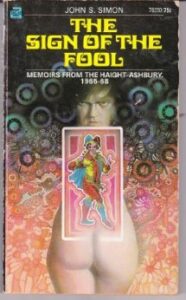
Coyote: I knew John Simon, and got him grants for his Poets in the Schools when I was running the California Arts Council. Haven’t read his book. I don’t know why he never mentioned me; I was there. Who knows, maybe he didn’t like me. Does it matter? The Communication Company was in my house for a while, certainly when we printed the first three issues of the Black Panther Party Newsletter. It would be hard not to mention me. But believe me, I’m not lonesome for publicity.
King: I am glad a fellow writer like John\”Spyder” received some grants. I heard he was in a bad way recently, financially and health-wise. I was just curious about inclusions and exclusions in memoirs. I spoke to Jerry Kamstra when we gave readings at the Sweetwater Beat event in January, regarding his memoir The Frisco Kid about late 50s early 60s in North Beach (pub. 1975). Kamstra told me, “Everybody got a little mad at me when the book came out. People got mad that I told the truth about them, and everybody else got mad that I left them out!”
Speaking of which, your fellow Digger, and good friend, Emmett Grogan, in his memoir Ringolevio, encountered that himself. You wrote the Introduction for the 1990 reprint. I read on the Digger website that “Many of Grogan’s compatriots felt betrayed and (even to this day) refused to read the book.” Did you get any of that attitude, too, about Sleeping?
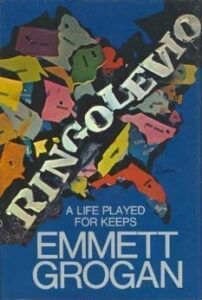 In 1978, 35-year-old Grogan was found dead from a heroin overdose on a subway train in Coney Island. Bob Dylan dedicated his 1978 album Street Legal to Grogan. Richard Brautigan dedicated his poem “Death Is a Beautiful Car Parked Only” to Grogan.
In 1978, 35-year-old Grogan was found dead from a heroin overdose on a subway train in Coney Island. Bob Dylan dedicated his 1978 album Street Legal to Grogan. Richard Brautigan dedicated his poem “Death Is a Beautiful Car Parked Only” to Grogan.
Coyote: I didn’t get a lot of static about my book because I played fair and was harder on myself than on other people. Emmett used his book to settle grudges and made himself out to be golden and bullet-proof. As Kent Minault said when he read it, “Oh yeah, Emmett sauntered and we all walked!” He lied when he didn’t have to. He was an amazing and talented guy, but he could go out to dinner with Tuesday Weld and Elizabeth Taylor, he did, and then he’d have to tell you that Marilyn Monroe was there too. She wasn’t.
Only one set of people got angry. The daughters of a close friend who lived at Olema, and that was when the edited version of the book —the first draft was 800 pages— cut out the stories about their father, a close friend, and reduced him to a one-liner about being a drug dealer. I agreed with them and rewrote his references for the second edition.
King: Drugs were a big part of the counterculture, the movies, art, the lifestyles, and making individuals and society wake up and change. But drugs were also a big part of the failure on so many other levels of our generation of 1960s through the 80s. So many deaths. You are a very lucky survivor. Why did we make what’s described in your book the “exhilarating highs of breaking the rules and redefining the permissible” so self-destructive?
Coyote: One of the reasons that we were all self-destructive was that we were intent on changing “out there” and paid no attention to “in here.” We had no vocabulary for interpersonal relations; settling disputes; no practices to soften our competitive edges or pacify our internal junkyard dogs. We did not look at our own shadows we arrived with, and consequently could not see the new ones we were creating by our labors. That’s it in a nutshell.
King: Wow. That’s good!
Coyote: That’s why I get the big bucks!
King: Many of the “been there, done that” folk in the Haight who were smart, or had the money such as the Dead, left the invasion of the flower children and the decline of the Haight shortly after the “Summer of Love,” or after the Altamont debacle. You were not one of the moneyed ones, but one of the smart ones. The last 2/3rds of your book is really about communal life. You lived as a communard with extended the Diggers\Free Family at communes here in Marin County at Olema, Forrest Knolls, and other places north of The City, right? The Gypsy Truckers appeared on the scene now and then?
Coyote: Yes. The Gypsy Truckers spent a winter at Olema. Some came on the Caravan with us to Colorado and others came to Turkey Ridge later. (Coyote’s family farm in Pennsylvania) Black Bear was way up at Trinity-Siskiyou. We had another house in Salmon Creek, another in Trinidad, CA. and a number of the Gypsy Truckers wound up in New Mexico.
King: TC Boyle* in “Drop City” gives a fictional account about 1970-commune life around Guerneville, CA and Alaska that is very dramatic. In that book and yours, it sounds like leaderless leadership, freeloaders, and non-stop sewage were universal bummers with commune life.
Coyote: (laughs) Yes. Life is full of contradictions. I was a leaderless “leader” at Olema by dint of being there first I suppose, but I was also half an idiot and pity anyone who “followed” me. Many communes were “Fools Schools” taking on people with no collective skills or instincts, and training them to go somewhere else, which they eventually did when they got tired of the madness. You can’t tell the one side without the other.
King: Another “in the middle of everything” memoirs, is “Just Kids,” Patti Smith’s 60’s memoir set in NYC. Have you read that? Patti did a nice job narrating her audiobook. I would have loved to hear your voice narrating your book! Was there a consideration for you to narrate your book?
Coyote: The publisher never considered doing my book as an audio book, so the answer is no.
King: Last issue we did two interviews with narrators Simon Vance and Paul Costanzo. You have an entire additional career in narration, having narrated numerous books, including Carlos Castaneda’s and the The Horse Whisperer. You were quoted as saying: “Just call him ‘Zero Defect Guy.’ That’s what the [audiobook] engineers have labeled me. I can do an hour-long documentary voice-over in an hour and 15 minutes.”
Coyote: (grins) I may not be “Zero” defects, but pretty damn close! I never read TC Boyle or Patti Smith’s book. I figured I lived it and didn’t need anyone else’s interpretation. Also, I burned it up in the living, and in the ten years it took to write my book I came to terms with everything and moved on. I never wanted to be like one of those frat boys who peaked in college and keep looking backwards. Still, I have a lot of respect for Boyle and Patti Smith. Are they good?
King: Both Boyle and Smith’s books are quite good. Smith lived the East Coast 60s scene, which I knew little about, but you do, too. She still met a lot of the San Francisco musicians like Janis and Jimi out there, as well as seemingly all of the New York who’s whos. You and Emmett Grogan set up base camp for a spell at New York’s infamous Chelsea Hotel, where Patti Smith lived and recounted. Your stories of dedicated scamming and networking in Janis Joplin’s vacated Chelsea rooms were ballsy. You and Grogan even managed to host a meeting at CBS’s penthouse boardroom between NYPD and Puerto Rican gang leaders! You two were just so – out there. How were you so fearless – how did you get away with this stuff?
Coyote: The New York scene was very different than the West Coast and I didn’t like it all that much. It was colder, harder, much more self-interested, much more attention paid to the building of careers and identities. The Diggers tried to stay more or less anonymous, but of course some of us were quite famous in the underground and Emmett and I could use that notoriety to meet person A. We’d talk, exchange gossip and figure out the value and utility of what we learned to someone else, and in that way we moved from the streets to the penthouses of NY.
Anyway, we had nothing to lose—no reputation, no career, no money. We were proud of living on our wits like feral cats, and what was amazing was that we received all the perks that the stars did—grand women, good drugs, access to any room we wanted—just by being ourselves. It was heady. I wish I’d used less heroin. I’d remember more of it. (laughs)
King: Like you, Smith was inspired by the poet Rimbaud, and she went out with Sam Shepard at one point, who’s world premier play “True West” you performed at the Magic Theater, re-launching your acting career.
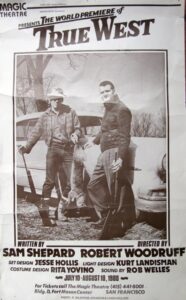 Advance poster from 1980 San Francisco’s Magic Theatre Premiere of True West. Note that future well-known actor’s names (Peter Coyote, Tom Dahlgren) do not yet appear. Coyote played Austin, the “good” brother. The play was so successful it went on to many productions, partnering variously, John Malkovich & Gary Sinise, Tommy Lee Jones & Peter Boyle, Dennis & Randy Quaid, Philip Seymour Hoffman & John C. Reilly. (Note that both J.Macon King and Perry King have worked at the Magic.)
Advance poster from 1980 San Francisco’s Magic Theatre Premiere of True West. Note that future well-known actor’s names (Peter Coyote, Tom Dahlgren) do not yet appear. Coyote played Austin, the “good” brother. The play was so successful it went on to many productions, partnering variously, John Malkovich & Gary Sinise, Tommy Lee Jones & Peter Boyle, Dennis & Randy Quaid, Philip Seymour Hoffman & John C. Reilly. (Note that both J.Macon King and Perry King have worked at the Magic.)
Coyote: Yes. I was at the Magic for two years. From the success of that experience and the confidence I gained being able to talk to all sorts of people from my work with the arts council, I decided to pursue a film career. However, the show itself was not much fun to do. I don’t want to gossip, so I’ll just leave it there. I’ll just say, if that was what “theater life” was going to be, I was happy to leap over into films. Also, I was 39 when I got my SAG card. I was a single father, dead broke, and I knew that I’d have to make some money to buy a house and get my kid, and later kids, through school. I was incredibly lucky and had a good run in films, but it seems to be over now.
King: Your fans are glad you took your run in the celluloid theatre! My favorite is your terrific performance in Polanski’s dark and sexy thriller, Bitter Moon.
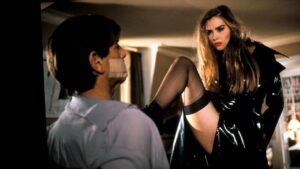 Bitter Moon. Coyote keeps the cruise ship waters hot with Emmanuelle Seigner, Hugh Grant and Kristin Scott Thomas. 1992.
Bitter Moon. Coyote keeps the cruise ship waters hot with Emmanuelle Seigner, Hugh Grant and Kristin Scott Thomas. 1992.
Coyote: Thanks.
King: But back to your writing…where are you now on your literary “Coyote Cycle?”
Coyote: I’ve just finished my second book, called The Rainman’s Third Cure, kind of a spiritual memoir about mentors, positive and negative, finally leading to discovering the place for wisdom in a world usually understood as offering only two options—between Love and Power. Remember Dylan’s song, “Stuck Inside of Mobile with the Memphis Blues Again”? He sings, “Well, the Rainman gave me two cures/and he said just jump right in/the one was Texas Medicine/the other was Railroad Gin… “I decided that for my purposes, Texas Medicine was peyote, and so I had it stand as a trope for the Ecstatic, the Utopian, the Collaborative—the world of Love. Railroad Gin was the drink of the Robber Barons, men and women who struggle for status, wealth, fame—and so it became my trope for the world of Power.
Then you get old. You see that your cards have all been dealt and you have no more draws. You’ll have to play what you have. You’ve suffered irreversible losses. Your body’s declined, your friends are dead…….this is the beginning of Wisdom, and so the book chronicles the passage through those worlds to reach the point where I made a decision to dedicate the rest of my life to staying in touch with and trying to speak from a place of wisdom. I happen to be a Buddhist priest, but wisdom is the human birthright….you don’t find it in just one path or religion, but you have to know it’s there, and then practice staying in touch with it.
King: Thanks so much. Keep the shiny side up!
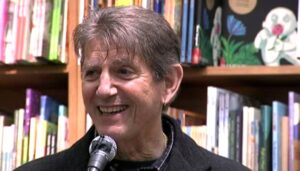 Coyote reads from The Rainman’s Third Cure in Larkspur, CA 2013. Photo: King.
Coyote reads from The Rainman’s Third Cure in Larkspur, CA 2013. Photo: King.
*See King’s interview with TC Boyle here.
END
Note: This interview originally appeared in these pages in 2013.